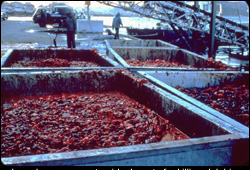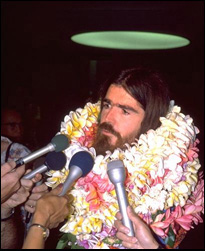As is often the case with our core issues, Greenpeace Foundation created the world focus on Japan’s dolphin kills in the late ’70’s by drawing attention to the ongoing “drive kills”. From 1978-1980, Greenpeace Foundation campaigner Dexter Cate traveled to Japan to work with local people to try ending these mass kills.
In a “drive kill”, dolphins are typically driven into an enclosed bay by a large group of boats clanging on pipes. The bay is netted off, and the dolphins slaughtered.
The high mercury levels of dolphin meat (dolphins are a top predator) made it unacceptable as a food except to poor coastal villagers. These villagers, when tested, had high mercury levels in their bodies, and were at risk for “Minimata Disease” (mercury poisoning) as it is known in Japan. The meat’s relative toxicity caused the government to order that the dolphins caught be ground up into mush and thrown on fields as fertilizer. Japan’s government paid a bounty equal to US$80 per head for each dolphin killed, under the “fewer dolphins, more fish for us” theory. Dexter returned repeatedly to work with local fishermen and authorities to find a way to stop the killing.
Finally, after two years of experiencing the carnage, Dexter took Sue White’s inflatable kayak and paddles with him on his 1980 trip to Japan. Again, he pleaded for the lives of some 400 bottlenosed dolphins which had been netted; and again he had to watch the killing begin. For a long day on Tatsunoshima Island, Dexter and his wife documented the kill for Greenpeace Foundation, capturing images that would shock the world. At the end of the day, the bay was filled with blood, but half of the dolphins remained alive. Dexter paddled the kayak across two miles of open sea in cold high winds to return to the island and release them. Untying the ropes which held the nets, he guided the dolphins into the sea. The next morning the fishermen found him sitting there to receive them, shivering with the cold, the dolphins gone. Dexter was arrested and held for 80 days in solitary at Sasebo Prison without being charged with a crime; and was ultimately deported. Greenpeace Foundation supported Dexter’s legal defense down to its last dollars. During that time, Japan’s treatment of dolphins became a world focus, which it has remained.
In the glare of publicity, Japan stopped paying a bounty on dolphins, and it is likely the drive kills would have ended if not for the intervention of entrepreneurs associated with the international “marine parks” industry, which has used the kills to cheaply supply performing dolphins. The first occurrence of this may have been a humanitarian gesture to save a few dolphins from a drive kill. However, it quickly became a partnership in which the money paid for the “performing” young dolphins became the main funding for the drive kills, even though them may constitute only a small percentage of the total pod. Although it is illegal for U.S. oceanariums to utilize capture methods that harm other members of a dolphin pod – and you can’t harm them much more than chopping all of them shrieking into pieces in front of their young – some of these drive-kill dolphins have made it into US oceanariums. With other oceanariums opening up around the world where regulations may be lax to nonexistent, the trade in young dolphins will presumably keep the coastal drive kills going as long as the customers of marine parks and “swim with” programs don’t ask – or care – how the dolphins were obtained. (Greenpeace Foundation considers this “marine park drive kill” industry detestable, and will continue to do what it can to end it.)
The USA’s oldest and original Greenpeace, proudly unaffiliated with Greenpeace USA





